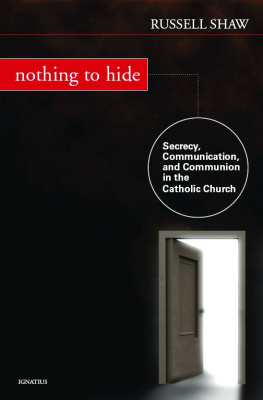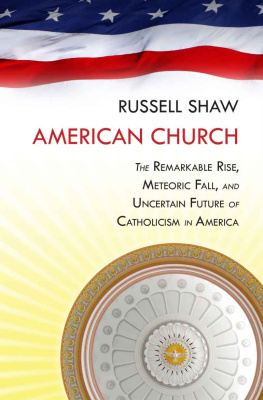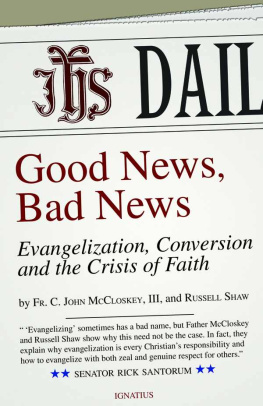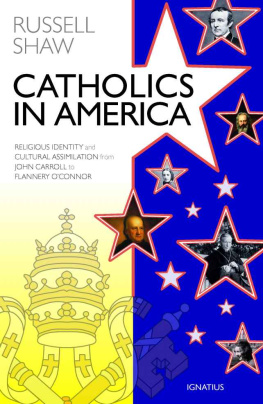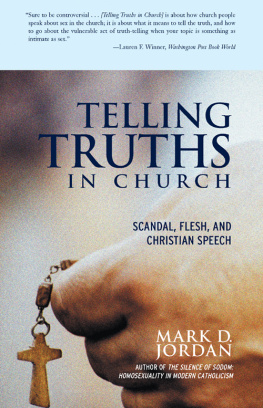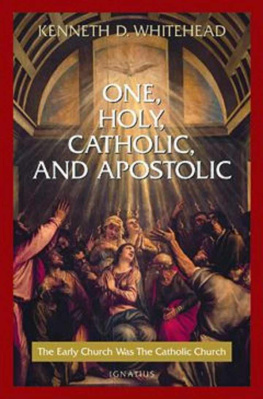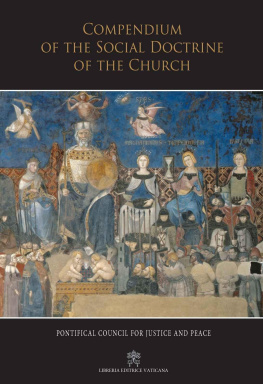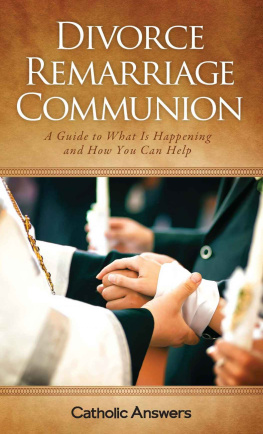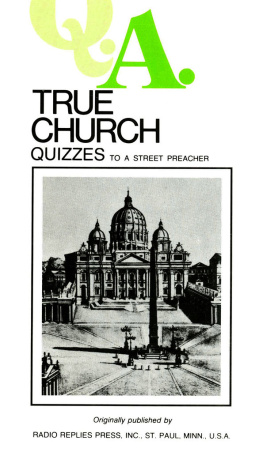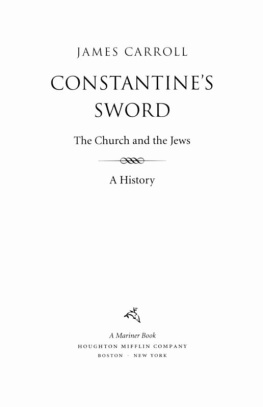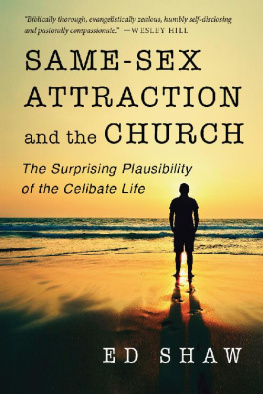NOTHING TO HIDE
NOTHING TO HIDE
Secrecy, Communication, and Communion
in the Catholic Church
By Russell Shaw
IGNATIUS PRESS SAN FRANCISCO
Cover art: iStockPhoto
Cover design by John Herreid
2008 by Ignatius Press, San Francisco
All rights reserved
ISBN 978-1-58617-218-3
Library of Congress Control Number 2007928876
Printed in the United States of America
CONTENTS
INTRODUCTION
The consequence is clear: we cannot communicate with the Lord if we do not communicate with one another.
Pope Benedict XVI
Let us begin with The Da Vinci Code . The book and the 2006 movie were based on the premise that the Catholic Church engaged in a huge deception about Christ from the very start. Their commercial success made it clear that many people either were willing to suspend disbelief long enough to enjoy the grotesque tale they told or else believed it.
The New York Times quoted one moviegoer: The Catholic Church has hidden a lot of thingsproof about the actual life of Jesus, about who wrote the Bible. All these peoplethe famous Luke, Mark and Johnhow did they know so much about Jesus life? If there was a Bible, who created it and how many times has it been changed? The newspaper identified the speaker as a twenty-five-year-old associate director of a Bronx senior centera Catholic who, it said, was baptized and confirmed in the church, went to Sunday school for six years, and still attends Mass twice a month.
The results of the cover-up of clergy sex abuse are visible in reactions like this. So are results of many other abuses of secrecy. The Da Vinci phenomenon capitalized on mistrust of the Church, and while much of that mistrust is unfair, that does not make it any less real. Even though some people seize on the Churchs alleged failures of candor to excuse their own dishonesties, in other cases mistrust is a reaction to real offenses against openness and honesty, past and present. There is an enormous amount of work to do to repair the damage to the Churchs credibility. And make no mistakecredibility is crucial to the Churchs success or failure in preaching the gospel.
Hence this book.
When I told an eminent theologian I was writing a book about the abuse of secrecy in the Catholic Church and its cousinslying, stonewalling, happy talk, failure to consult, and the restand would appreciate having his advice on sources to consult, he told me to read canon law. I havent thought much about secrecy, but its a canonical question, he explained.
So I read canon law. I found canons dealing with secret records and archives, the seal of the confessional, and the secrecy of the ecclesiastical courts called tribunals that handle marriage cases. All this was interesting, but it was not what I was looking for, and it is not what this book is about.
Nothing to Hide is not concerned with legitimate secrecy of the kind required to protect confidential records and peoples reputations. It is concerned with the stifling, deadening misuse of secrecy that does immense injury to communion and community in the Church.
And, despite what my friend the theologian said, that kind of secrecy is a theological problem as well as a practical one. Specifically, it is a problem rooted in ecclesiology, the theology of the Church. The questions it raises boil down to these: What kind of church do we want our Church to be, open or closed? What kind of church should it be? And how much secrecy is compatible with having such a church?
A kind of inverted logic often enters into the discussion of these questions. The Church is a communion, not a political democracy, it is said; therefore openness and accountability do not count for too much in the Church. But the argument should go just the other way around: the Church is a communion, not a political democracy; therefore openness and accountability are even more important in the Church than they are in a democracy.
In a paper delivered some twenty years ago to a conference for the continuing education of priests, Joseph Cardinal Ratzingernow Pope Benedict XVIhad this to say about the reality of ecclesial communion:
Fellowship in the body of Christ and in receiving the Body of Christ means fellowship with one another. This of its very nature includes mutual acceptance, giving and receiving on both sides, and readiness to share ones goods.... In this sense, the social question is given quite a central place in the theological heart of the concept of communion.
Among the goods to be shared, one might add, it is appropriate and necessary to include, along with materials goods, the goods of truthfulness and honesty.
This is a beautiful vision of the Church. In its own small way, the present book seeks to make a modest contribution to realizing it in the concrete circumstances of the present day, by helping to end the culture of secrecy, first in American Catholicism and then, one hopes, beyond it as well, and replacing that destructive culture with an open, accountable community of faith.

Nothing to Hide is organized as follows.
Chapter 1 is an introduction to the nature and dimensions of the problem as it now exists.
Chapter 2 offers a brief historical overview, focusing especially on the First Vatican Council (1869-1870) and the Second Vatican Council (1962-1965).
Chapter 3 examines the abuse of secrecy in the Churchs media relations, with particular attention to the ups and downs in the practice of the Catholic bishops conference of the United States since Vatican Council II.
Chapter 4 discusses issues of internal communication in contemporary Catholicism.
Chapter 5 presents some preliminary reflections relevant to the development of a theology of openness in the Church.
Chapter 6 makes concrete suggestions concerning steps to take in order to foster openness, accountability, and shared responsibility in Catholic life.
The book contains many anecdotes, and there is a reason for that. In speaking about the abuse of secrecy in the Church, I have often encountered denialthe refusal to see, much less admit, that there is much of a problem here. People in positions of authority are particularly likely to react that way. So it is necessary to show in concrete terms that the problem does exist and that it is serious. Anecdotes are a way of doing that. Some of the incidents recorded here are small, even trivial, and some plainly are not. All of them are drawn from real life. Taken together, large or small, they add up to a disturbing picture.
Someone who read a draft of this book complained that I was attributing moral fault to people in leadership positions in the Church. That is a bad misreading of what the book says. The problem examined herethe abuse of secrecyis a systemic one with a long history. People take it for granted as part of the way we have grown accustomed to doing business. It is not a moral fault, but it is a serious mistake that does the entire Church much harm.
With only a few exceptions, I am speaking in this book about American Catholicism. The Vatican and the Church in other countries have their own histories, their own customs and cultures, and it is not any business of mine to diagnose and prescribe concerning what I understand either imperfectly or not at all. American Catholicism is a different story. I have been an American Catholic all my life, and, based on personal and professional experience, I think I am qualified to speak about the Churchs culture of secrecy and the faults and flaws in her structures and practice of communication as I have experienced them.
I encourage others to do the same and in this way make their contribution to the fellowship in the body of Christ of which Pope Benedict speaks.
Next page
